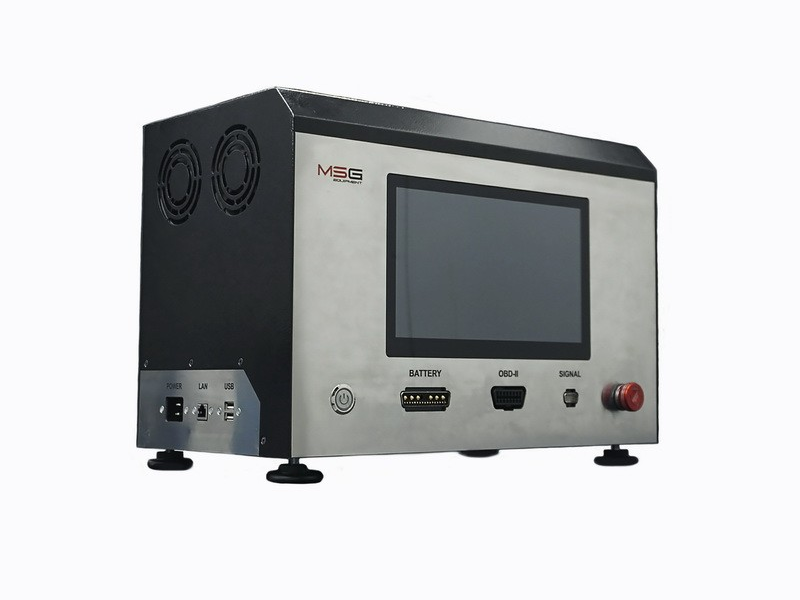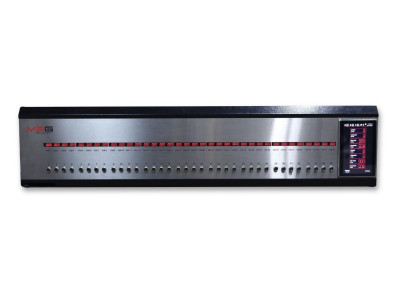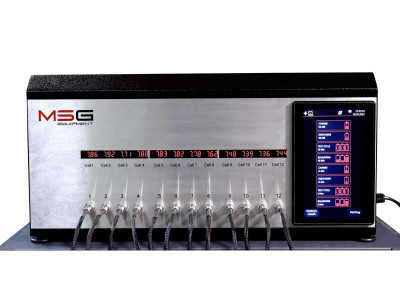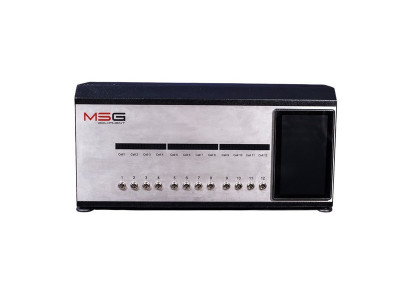MS801
Tester for diagnosing lithium battery modules of electric and hybrid vehicles
The MS801 tester is designed for diagnosing lithium-ion modules of high-voltage batteries in electric and hybrid vehicles, as well as 48-volt batteries of "mild hybrids" (MHEV).
Manufacturer:
MSG Equipment
The MS801 is a modern solution for service centers and professionals involved in the maintenance and repair of high-voltage batteries in electric and hybrid vehicles. The tester enables diagnostics of lithium-ion high-voltage battery modules with voltages up to 62 V, including 48-volt mild hybrid (MHEV) batteries.
Tester Capabilities:
- Determining the capacity of lithium-ion battery modules with voltages up to 62 V:
- 2 to 15 cells in series with a maximum voltage of 4.2V per cell;
- 2 to 15 cells in series with a maximum voltage of 4.2V per cell. - Diagnostics of 48V mild hybrid vehicle (MHEV) batteries controlled via the CAN bus.
- Diagnostics of battery modules controlled via RS485.
- The tester has an OBDII connector to which a diagnostic scanner can be connected to read data from the BMS module.
- Monitoring the temperature of module cells.
- Reverse polarity protection (incorrect connection).
Functions:
- Module charging with a current up to 80 A.
- Regenerative discharge with a current up to 90 A (during discharge, energy is returned to the grid) with capacity measurement.
- Battery internal resistance and intercell connection quality testing.
- Active balancing function for module cells with a current from 0.05 to 2 A (16 channels). Balancing is performed with simultaneous charging and discharging of cells in the module, which significantly reduces balancing time.
Features:
- Compact dimensions.
- Automatic diagnostic mode based on user-configurable scenarios.
- Remote tester control over a local network.
- Specialized cables for simple and safe module connection.
- Report generation in PDF format.
- Free software updates.
Attention! Setting incorrect test parameters may cause damage to the diagnosed module.
Technical Specifications
Supply voltage, V
230
Power consumption, kW
2.2
Software update
available
Working with data buses
CAN, RS485
Types of protection
- against polarity reversal; - short-circuit of the connected cable; - from overheating.
Connecting the diagnostic scanner
OBDII
Control
capacitive touchscreen 10.1", remote control over a local area network
Saving diagnostic results
available
Connection of peripheral devices
2 x USB 2.0; 1 x LAN; WiFi
Width, m
0,44
Depth, m
0,27
Height, m
0,32
Weight, kg
19
Number of channels for module test
16
Max. channel voltage for Li-Ion, V
5.0
Charge rate, A
up to 80
Discharge rate, A
up to 90
Power source
single-phase electrical network
Energy recycling power (max), kW
1.85
Maximum battery module voltage, V
62
Number of series-connected cells (LiFePO4)
from 3 to 16
Energy recycling during discharge
yes
Number of series-connected cells (Li-ion, 4.2V)
from 2 to 15
Peak current for internal resistance test of cells
up to 120 A (test time 250 ms)
Number of balancing channels
16
Balancing current (charge, discharge), A
from 0.05 to 2
Maximum balancing voltage, V
4.2
Video overview
Related videos
Training course on diagnostics and repair of high-voltage batteries for hybrid and electric vehicles
A training course on the diagnostics, maintenance, and repair of high-voltage batteries in electric vehicles. You will study the battery design, learn how to work safely with high-voltage circuits, and use professional equipment to assess their condition.
Click the link to learn more about the course
Related Products
MS800
Tester for diagnostics of battery hybrid and electric vehicles
The MS800 tester is designed for diagnosing high-voltage nickel-metal hydride (Ni-Mh) and lithium-ion (Li-ion) batteries in hybrid and electric vehicles.
Number of channels for module test
36
Charge rate, A
from 0.1 tо 4.5
Discharge rate, A
from 0.1 to 5 (limited to 50 W per channel)
Number of channels for module test
36
Charge rate, A
from 0.1 tо 4.5
Discharge rate, A
from 0.1 to 5 (limited to 50 W per channel)
MS800A
Tester for diagnostics of battery hybrid and electric vehicles
The MS800А tester is designed for diagnosing high-voltage nickel-metal hydride (Ni-Mh) and lithium-ion (Li-ion) batteries in hybrid and electric vehicles. The tester provides simul...
Number of channels for module test
12
Charge rate, A
from 0.1 tо 4.5
Discharge rate, A
from 0.1 to 5 (limited to 50 W per channel)
Number of channels for module test
12
Charge rate, A
from 0.1 tо 4.5
Discharge rate, A
from 0.1 to 5 (limited to 50 W per channel)
Materials about MS801 to download:
Format
Name
Latest update












